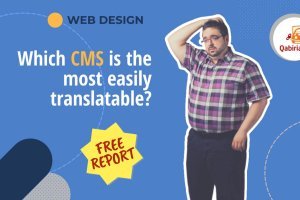
Table of Contents
Your site is struggling to take off. All the experts tell you that you have to add more contents. And after listening to them , you decide to give the writing assignment to someone on your team.
And that’s when the problems begin.
You explain to your colleague in charge of the site that you need a blog post, but you’re handed an article that doesn't look anything like what you had in mind.
Then try a freelancer. Same result.
So you hire an external agency. Nothing, the text doesn't reflect your intentions.
In despair, you wonder if they’re all incompetent or if...maybe the problem is you. Is it possible that there is no way to simplify the process from idea to draft?
There’s no system to improve the interaction with the author-editor, web writer, copywriter, content writer, or whatever we want to call the person who will actually write the content?
Fortunately, there is: and it is by using a content template.
The content template is a card that serves as a template for creating the content you need for your website.
I already know what you’re thinking: “Ugh, another hassle to deal with... Is that really necessary? Shouldn't a web writer already know how to write without me telling him?”
Yes and no.
A professional and qualified web writer knows how to structure a readable text, according to the rules of SEO, that captures the attention of your audience and conveys the message. In short, he knows how to write, but — unless you tell him — he doesn't know what to write about.
This explanatory effort falls on you.
It’s not an inhumane effort, but it does require a pause for thought.
Before you start writing, you need to ask yourself a few questions. The answers to these questions — along with a preliminary research work on the topic to be deal with and some metadata essential for the article — must come together in a document that you will give to the web writer. This document is the content template.
Don’t worry: at the end of the article you can download a sample content template to adapt to your purposes.
The 4 questions to get started
The main questions to think about what content to write for your site are:
- What kind of content should you write? It’s one thing to write a blog post, another to write a description of a product or service, yet another to write a help or explanatory page.
- Who are you addressing? You need to define exactly who will be reading the text. If it coincides with your usual audience, you can build it on your buyer persona. If the text serves other purposes, you’ll need to think about the new target audience and figure out what they expect from the text.
- What is the purpose of the page on which the text will be posted? You need to think about the relationship of the new page to the rest of the site. If it’s just one article in more than one series, then it will share the setting and style with the rest of the articles. If it’s a landing page, it will aim to capture attention to a certain product. And so on.
- And most importantly: **the content you need to create, what question from your audience does it answer?
This last point is particularly important. As you know, for Google every search corresponds to a user question and a search intent on his part.
The search intent is the main purpose of a user when typing a search query in Google or another search engine. Usually this purpose falls into one of these four categories:
- informational, when the user is looking for information or an opinion on a certain topic;
- navigational, when searching for the address of a site or page;
- commercial, when he wants information about a product or service;
- transactional, when the user has already decided what to buy and wants to complete the purchase.
If you want your web page to rank high, you need to predict as accurately as possible what user question the page is answering and what its purpose is.
Notwithstanding that you should always write for users, rather than search engines. If readers like a text, Google will certainly like it, but it will not always be the opposite.
Preliminary research
To discover the most frequently used search keys by your potential audience, you need to perform several keyword searches. The keyword research is the process by which you identify the most relevant and the most searched keywords regarding your content and in line with the search intent** of your audience.
Keyword research is done with special tools such as Ahrefs, Moz, Ubersuggest or Serpstat.
For example, let’s say your site needs a blog post on supplementary pensions.
The basic keywords
The first step is to enter the basic keyword into one of these tools, and then analyse the results.
There is usually a page that summarises the “behaviour” of the keyword, where you can find out how many times a month that keyword is searched (Volume), how difficult it is to rank a page from 0 to 100 (Competition), how much it costs a click if you want to place an ad for that keyword, and how difficult it is to get in the top 10 results (KW difficulty). These parameters vary from tool to tool, but all aim to assess the opportunity represented by a keyword for your business.

All keyword search tools also provide a list of combinations of the searched keyword.
Use this list to define which combinations are relevant and appropriate for your content, in order to insert those words into the text.

Another function is that of suggested keywords, i.e. keywords that belong to the same field as the main one.
This list is useful for developing the topic by touching on other topics closely related to the main one that you may not have thought of.

Keyword research is not easy and — on its own — is a topic that would deserve an article in its own right. We suggest you read the materials provided by Ahrefs or Kinsta to learn more about it.
Mark your primary and secondary keywords, because you will need to include them in the content template.
Competitive analysis
Once the primary and secondary keywords to be included in the text have been identified, the next step is the comparison with your competitors.
The above mentioned tools provide you with a list of the best-performing pages, that is, those that appear at the top of searches for the main keyword you choose.

See which sites appear at the top of the search engine results for your chosen query.
If the first few pages address the issue in depth and answer 100 percent of your ideal user’s question, know that it will be difficult (but not impossible) to undermine them.
Instead, if unhelpful articles with superficial content also appear in the first positions, then you can well hope to place your page at the top.
A strategy that almost always pays off is to build your content according to the lack of your competitors.
For example, if the competition article on supplementary pensions does not discuss the latest legislation on the subject, you could add a section on just that to provide an article that addresses the issue more fully.
Take note of the best positioned competitor sites and the features you would also like to see in your article, so you can explain this to your web writer. These links should be included in the content template, so that the editors have comparative parameters.
Checklist, length and essential metadata
Having finished the competitive analysis, in order for web writers to find the right balance between SEO and user needs, we recommend that you prepare a checklist with everything you need to know before creating an article or text for your site:
- best practices for metadata (how long should they be, how should they be structured, etc. Let’s get into the real SEO field)
- directions on how to write the URL of the page (it will depend on how you have structured your site. Look here for more information and ask your webmaster if you have doubts)
- what names to give to images and how to use the ALT tag
Another indispensable element is the recommended text length. There are no fixed rules in this respect. On the one hand, it is often said that internet users do not like to read long texts, but on the other hand, it is true that if a piece of content awakens a reader’s interest, he or she is willing to read it even if it is very long. In any case, the recommended length should be based on that of the best-ranked pages you identified in the competitive analysis phase. If that length brought certain pages to the top of the search results, you can reasonably assume that it is the right one.
Web writers often charge their rate based on the length of the article. It is therefore doubly important to establish the desired length from the beginning to avoid surprises.
Next you must prepare essential metadata for the article in question. If you circumscribe the topic with the right metadata, your web writer will understand what his or her “wiggle room” is and neither go off topic nor stay too specific.
Here are what metadata and elements you need to include in the content template:
- page title; if you still haven't decided on an exact title, put up a tentative one and ask the web writer to suggest some more catchy alternatives;
- meta description: 160 characters to summarise the content of your page and entice a click;
- main header h1 (see above);
- Second- and third-level headings, which are the various sections into which the text will be divided (they correspond to the h2 and h3 tags);
- Internal links, that is, which other pages on the site to link to the new article and which texts to choose for the anchor.
Let’s return to the example in the blog post on supplementary pensions. If you decided to approach the topic from the perspective of comparing products, then responding to a hypothetical “commercial” search intent, the title of the page might coincide with the main header and be “What are the best supplementary pensions in 2021?”
Second- and third-level headings could instead refer to “difference between open and closed pension fund”, or “individual pension plan”, or other subcategories and topics related to the main theme.
In the content template you should then add:
- the main keywords chosen, with their monthly search volume, if you have this data available;
- the secondary keywords;
- any tags and categories, if your site uses this type of taxonomy to classify content.
It is also useful to indicate whether the text should be “seasonal” or “evergreen” , that is, whether it can contain data related to current events or whether you want an article that has no “expiration date”. The web writer will adapt the references accordingly.
One step further: the guidelines for writing content
At this point it should be clear what elements to include in a content template.
If you want to improve the output of your web writers even more, you can take an additional step: prepare guidelines for content writing.
The document with the guidelines further binds the editors because it establishes certain technical, typographical and style guidelines that they must adhere to when working with your company.
Technical directions change depending on the CMS system you use for your site. The goal is to receive texts from web writers that can be entered directly into the CMS without having to waste time changing the [formatting](/translation/ layout-dtp).
For example, if your CMS uses the markdown format, the guidelines should explain in brief how to format titles, bold, italics and links with this language.
Typographical indications should clarify to editors the criteria to be followed when, for instance, quoting someone else’s article, book or other work. Or how to format quotations of sentences, when to use capital letters, when to use italics, what kind of inverted commas to use, etc.
Finally, style guidelines encompass an even broader field and serve to give consistency to the texts on your site. Creating a style guide is considerable work, but it has a great advantage: will cause all author-editors to speak in your company’s tone of voice. We will certainly address this topic in one of our upcoming articles.
Well, now it’s your turn.
Download the sample content template for your web writers here and use it for your next article. Then let us know how it went, in the comments or on LinkedIn, whichever you prefer. And if you need help to fill in the template or if you want to avoid headaches when having your web content written, don’t hesitate: contact us and we will help.






